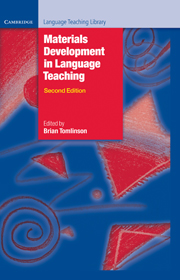Book contents
- Frontmatter
- Contents
- Preface
- Glossary of basic terms for materials development in language teaching
- Acknowledgements
- 1 Introduction: principles and procedures of materials development
- Part A Data collection and materials development
- 2 Using corpora in the language classroom
- 3 Concordances in the classroom without a computer: assembling and exploiting concordances of common words
- 4 Telling tails: grammar, the spoken language and materials development
- Comments on Part A
- Part B The process of materials writing
- 5 A framework for materials writing
- 6 Writing course materials for the world: a great compromise
- 7 How writers write: testimony from authors
- Comments on Part B
- Part C The process of materials evaluation
- 8 The analysis of language teaching materials: inside the Trojan Horse
- 9 Macro- and micro-evaluations of task-based teaching
- 10 What do teachers really want from coursebooks?
- 11 The process of evaluation: a publisher’s view
- Comments on Part C
- Part D The electronic delivery of materials
- 12 Developing language-learning materials with technology
- 13 New technologies to support language learning
- Comments on Part D
- Part E Ideas for materials development
- 14 Seeing what they mean: helping L2 readers to visualise
- 15 Squaring the circle – reconciling materials as constraint with materials as empowerment
- 16 Lozanov and the teaching text
- 17 Access-self materials
- Comments on Part E
- Conclusions
- Recommended reading
- Index
14 - Seeing what they mean: helping L2 readers to visualise
Published online by Cambridge University Press: 09 February 2023
- Frontmatter
- Contents
- Preface
- Glossary of basic terms for materials development in language teaching
- Acknowledgements
- 1 Introduction: principles and procedures of materials development
- Part A Data collection and materials development
- 2 Using corpora in the language classroom
- 3 Concordances in the classroom without a computer: assembling and exploiting concordances of common words
- 4 Telling tails: grammar, the spoken language and materials development
- Comments on Part A
- Part B The process of materials writing
- 5 A framework for materials writing
- 6 Writing course materials for the world: a great compromise
- 7 How writers write: testimony from authors
- Comments on Part B
- Part C The process of materials evaluation
- 8 The analysis of language teaching materials: inside the Trojan Horse
- 9 Macro- and micro-evaluations of task-based teaching
- 10 What do teachers really want from coursebooks?
- 11 The process of evaluation: a publisher’s view
- Comments on Part C
- Part D The electronic delivery of materials
- 12 Developing language-learning materials with technology
- 13 New technologies to support language learning
- Comments on Part D
- Part E Ideas for materials development
- 14 Seeing what they mean: helping L2 readers to visualise
- 15 Squaring the circle – reconciling materials as constraint with materials as empowerment
- 16 Lozanov and the teaching text
- 17 Access-self materials
- Comments on Part E
- Conclusions
- Recommended reading
- Index
Summary
Introduction
There is currently much concern about the apparent mismatch between what learners are asked to do in published textbooks and the reality of language use; see, for example, Masuhara et al . ( 2008 ), Tomlinson ( 2008 ) and ( 2009 ), and Tomlinson et al . ( 2001 ), as well as the chapters in Part A of this book by Jane Willis and by Ronald Carter, Rebecca Hughes and Michael McCarthy. Many think that there is also a mismatch between some of the pedagogic procedures of current textbooks and what second language acquisition researchers have discovered about the process of learning a second or foreign language (see, for example, Chapter 1 of this book by Brian Tomlinson and Chapter 8 by Andrew Littlejohn). One type of textbook which seems to be largely exempt from such criticisms of mismatch is that which focuses on helping learners to develop reading skills in an L2.
It seems to be accepted that current textbook activities designed to develop reading skills do to a large extent mirror the actual pro - cess of reading authentic texts. These activities are based on generally accepted models of the reading process which stress the active role of the reader in relating world knowledge to information in the text, the parallel interaction between low-level decoding of words and high-level processing of concepts and the way in which effective readers vary their reading techniques according to their purposes for reading. However, it is arguable that there is one significant reading strategy which has been almost entirely neglected by both general EFL coursebooks and by EFL reading skills books too. That is the strategy of visualisation, the converting of words on the page into pictures in the mind. In an analysis of EFL textbooks published in the 1990s I found no evidence at all of any systematic attempt to help L2 learners to develop visualisation skills except in Openings (Tomlinson 1994 ) and Use Your English (Tomlinson and Masuhara 1994 ). And when reviewing EFL textbooks in the last ten years (e.g. Masuhara et al . 2008 ; Tomlinson et al . 2001 ) I still have not found any attempt to help L2 readers to achieve visual imaging of reading texts.
- Type
- Chapter
- Information
- Materials Development in Language Teaching , pp. 357 - 378Publisher: Cambridge University PressPrint publication year: 2011
- 6
- Cited by

